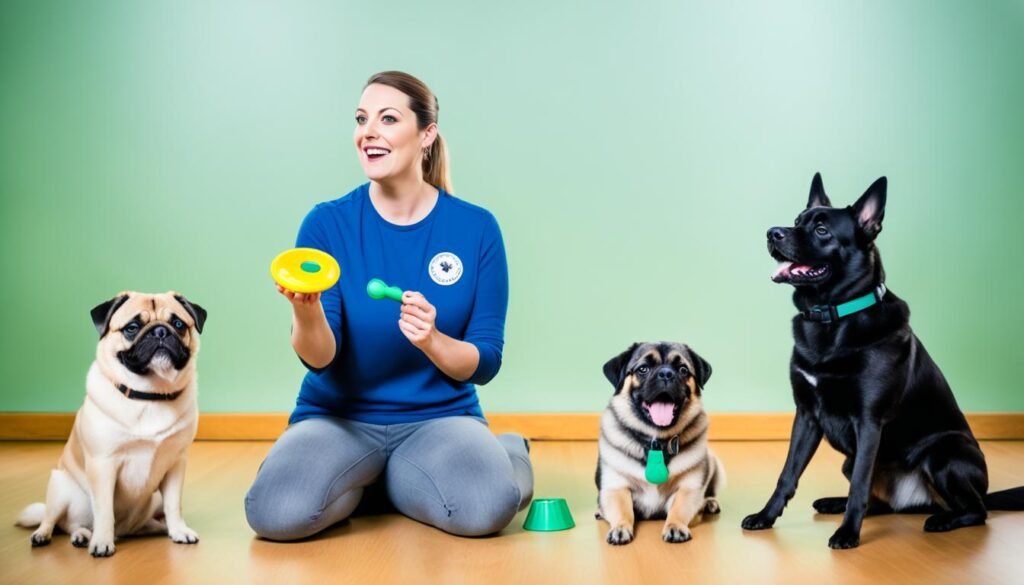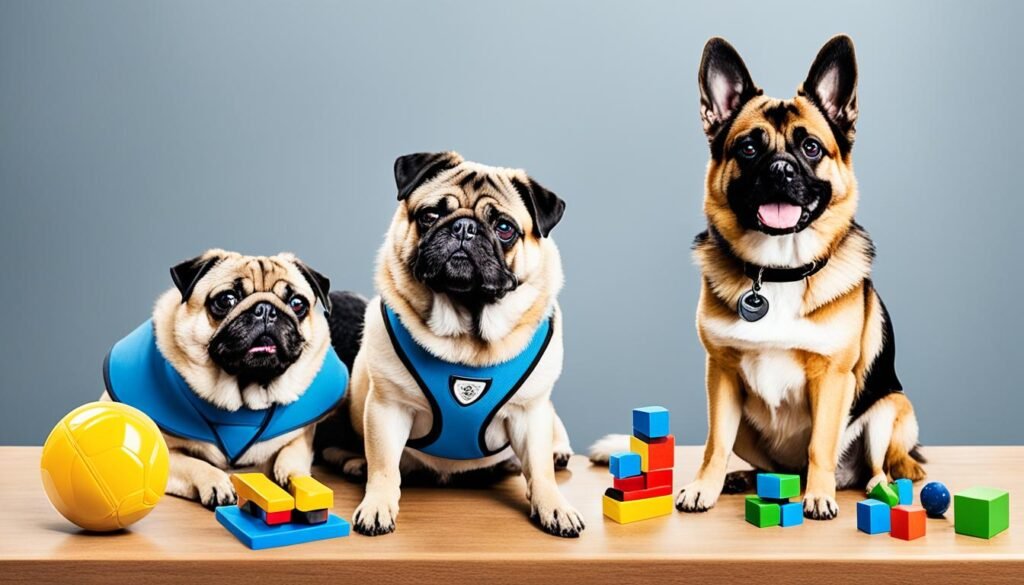Pug vs German Shepherd: Which Breed Is Easier to Train?
About 73% of dog owners think training their pets is key for a happy home. This shows how vital it is to know which breed, like the Pug vs German Shepherd, is simpler to train. I’ve seen both breeds up close, and they each have traits that affect how easy they are to train.
We’re going to look into the unique traits of Pugs and German Shepherds. This will help us understand their training needs. Knowing which breed is simpler to train can make your bond stronger and keep your home peaceful.
Understanding the Basics of Dog Training
When I began dog training, I learned that knowing the basics is crucial. It helps train any dog effectively. Positive reinforcement is a top method that rewards good behavior, not bad. This approach is favored by many owners.
Consistency is key in training. Regular practice strengthens the bond between dog and owner. It also helps solidify the skills a puppy learns. Early training makes future training easier.
Each breed has its own traits that affect training. Pugs like playful, treat-based methods. German Shepherds do well with structured training because they’re smart and eager to please. Finding the right approach is important for successful training.

Using different and fun training methods keeps my dog engaged and happy. Learning about each breed’s needs helps me train better.
Dog Intelligence and Trainability
Understanding dog intelligence is complex. Many things affect how easy a dog is to train, like their instincts and personality. Some breeds learn new commands quickly, while others need more time and effort. This makes me ask, which breed is easier to train?
The German Shepherd is known for its high intelligence and willingness to work with people. They can learn complex tasks easily. This makes them one of the best breeds for training, often used as service and working dogs.
Pugs, on the other hand, have their own way of learning. They might not be as smart as German Shepherds, but they’re eager and fun to train. Their playful nature can make them easily distracted, so training them requires special strategies.
Knowing how different breeds think can really help with training. By understanding each breed’s strengths and weaknesses, trainers can make training better for both dogs and owners.

Pug vs German Shepherd: Which Breed Is Easier to Train?
When looking at training ease between Pugs and German Shepherds, many factors matter. German Shepherds are known for their intelligence and desire to please. This loyalty and strong work ethic makes them great for many tasks, like obedience training and service roles. They are usually easy to train because of their german shepherd temperament, which helps them follow commands well.
Pugs are also smart, but they can be stubborn, making training harder. The pug temperament often means they like to do things their way, questioning commands instead of just following them. This might make training take longer and require patience from owners.
Knowing these temperament differences helps potential dog owners make better choices. If you want a dog that listens well and learns quickly, a German Shepherd might be best. But if you like a more laid-back training process with some stubbornness, a Pug could be ideal.

Temperament Differences Between Pugs and German Shepherds
Understanding the temperaments of different dog breeds is key to effective training. Each breed has its own set of traits that affect how they learn and interact with trainers. Here, we’ll explore the unique temperaments of Pugs and German Shepherds. This will show how these traits influence training methods.
Pug Temperament
Pugs are known for being friendly and loving. Their sweet nature makes them great friends. Key traits of pugs include:
- Mischievousness: Pugs love to play and can sometimes act a bit naughty.
- Affectionate: They enjoy being around people and love to be close to their owners.
- Stubbornness: This trait can make training challenging, as they might not always listen.
Despite their stubbornness, a pug’s love for people makes training them rewarding. Owners often find creative ways to motivate them.
German Shepherd Temperament
German Shepherds are known for their loyalty and smarts. They are protective and make great working dogs. Key traits of German Shepherds include:
- Loyalty: They bond strongly with their families, offering a sense of safety.
- Protectiveness: They guard their territory and loved ones, which helps in training.
- Keen intelligence: Their sharp minds make them easy to train if socialized early.
Considering these traits, German Shepherds do well in training. They thrive when given specific tasks and responsibilities.
Socialization and Its Importance in Training
Socialization is crucial for training my dog, especially for breeds like Pugs and German Shepherds. It helps them get used to different people, pets, and places. This makes them behave better throughout their lives. I’ve seen how early, positive experiences can stop future problems.
German Shepherds are very sensitive to their world. Socializing them helps them fit in better. Pugs also gain a lot from meeting other dogs and seeing new places. I’ve found that showing my dog different things makes them happier and less worried.
- Start early: Begin socialization as soon as you bring your dog home.
- Positive experiences: Create joyous interactions to reinforce good behavior.
- Diverse encounters: Aim for a variety of people, pets, and settings.
Using these tips helps my dog become confident and friendly with the family. With time and effort, a well-socialized dog brings more peace to our home.
Obedience Training: Techniques and Tips
Starting obedience training with my dog means focusing on methods that work well. Pugs and German Shepherds can do great with the right training. It’s important to adjust training to fit each breed’s needs.
Consistency is key in training. I always use the same commands and signals. This makes it clear to my dog what I want. Repetition is also key. Practicing commands like “sit,” “stay,” and “come” every day helps them learn.
Positive reinforcement makes training better. Giving my dog treats or praise when they do something right encourages them to do it again. What rewards work best can vary by breed. For example, Pugs might love belly rubs, while German Shepherds might like their favorite toy.
Patience is vital in training. I set achievable goals and remember that each dog learns at their own speed. Short, effective training sessions keep my dog interested. This way, both my Pug and German Shepherd stay focused and happy.
Here’s a quick list of training techniques I find effective:
- Use consistent commands for clarity.
- Incorporate repetition into daily activities.
- Apply positive reinforcement for desired behaviors.
- Be patient and adjust expectations according to each dog’s learning pace.
- Keep training sessions short and enjoyable.
Using these strategies in obedience training strengthens my bond with my dogs and improves their skills. Knowing what motivates them helps me train them better. This way, training is rewarding for both of us.
Active Dog Breeds and Their Training Needs
Active dog breeds need special training. The German Shepherd is smart and full of energy. They need both physical and mental challenges to stay happy.
Training for German Shepherds as Active Dogs
German Shepherds love to please and learn quickly. But, they can’t just sit and listen. I mix fun exercises with training to keep them interested.
This keeps training fun and helps them use their energy. It makes sure they pay attention and stay focused.
Adding these activities to their routine makes them great family pets. They love challenges and can learn complex things. This shows why people often ask which breed is easier to train. With the right mix of training and exercise, these dogs become loyal and smart companions.

